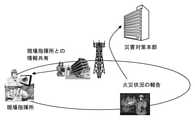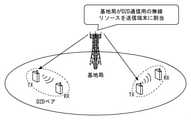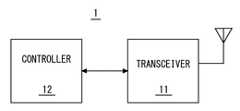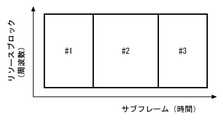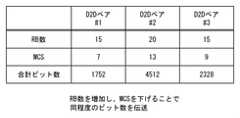JP7006611B2 - Radio base station and radio resource allocation method - Google Patents
Radio base station and radio resource allocation methodDownload PDFInfo
- Publication number
- JP7006611B2 JP7006611B2JP2018547511AJP2018547511AJP7006611B2JP 7006611 B2JP7006611 B2JP 7006611B2JP 2018547511 AJP2018547511 AJP 2018547511AJP 2018547511 AJP2018547511 AJP 2018547511AJP 7006611 B2JP7006611 B2JP 7006611B2
- Authority
- JP
- Japan
- Prior art keywords
- radio
- guaranteed
- band
- mcs
- wireless
- Prior art date
- Legal status (The legal status is an assumption and is not a legal conclusion. Google has not performed a legal analysis and makes no representation as to the accuracy of the status listed.)
- Expired - Fee Related
Links
Images
Classifications
- H—ELECTRICITY
- H04—ELECTRIC COMMUNICATION TECHNIQUE
- H04W—WIRELESS COMMUNICATION NETWORKS
- H04W28/00—Network traffic management; Network resource management
- H04W28/16—Central resource management; Negotiation of resources or communication parameters, e.g. negotiating bandwidth or QoS [Quality of Service]
- H04W28/18—Negotiating wireless communication parameters
- H04W28/20—Negotiating bandwidth
- H—ELECTRICITY
- H04—ELECTRIC COMMUNICATION TECHNIQUE
- H04L—TRANSMISSION OF DIGITAL INFORMATION, e.g. TELEGRAPHIC COMMUNICATION
- H04L1/00—Arrangements for detecting or preventing errors in the information received
- H04L1/0001—Systems modifying transmission characteristics according to link quality, e.g. power backoff
- H04L1/0002—Systems modifying transmission characteristics according to link quality, e.g. power backoff by adapting the transmission rate
- H04L1/0003—Systems modifying transmission characteristics according to link quality, e.g. power backoff by adapting the transmission rate by switching between different modulation schemes
- H—ELECTRICITY
- H04—ELECTRIC COMMUNICATION TECHNIQUE
- H04L—TRANSMISSION OF DIGITAL INFORMATION, e.g. TELEGRAPHIC COMMUNICATION
- H04L5/00—Arrangements affording multiple use of the transmission path
- H04L5/003—Arrangements for allocating sub-channels of the transmission path
- H04L5/0037—Inter-user or inter-terminal allocation
- H—ELECTRICITY
- H04—ELECTRIC COMMUNICATION TECHNIQUE
- H04W—WIRELESS COMMUNICATION NETWORKS
- H04W4/00—Services specially adapted for wireless communication networks; Facilities therefor
- H04W4/70—Services for machine-to-machine communication [M2M] or machine type communication [MTC]
- H—ELECTRICITY
- H04—ELECTRIC COMMUNICATION TECHNIQUE
- H04W—WIRELESS COMMUNICATION NETWORKS
- H04W4/00—Services specially adapted for wireless communication networks; Facilities therefor
- H04W4/90—Services for handling of emergency or hazardous situations, e.g. earthquake and tsunami warning systems [ETWS]
- H—ELECTRICITY
- H04—ELECTRIC COMMUNICATION TECHNIQUE
- H04W—WIRELESS COMMUNICATION NETWORKS
- H04W72/00—Local resource management
- H04W72/50—Allocation or scheduling criteria for wireless resources
- H04W72/51—Allocation or scheduling criteria for wireless resources based on terminal or device properties
- H—ELECTRICITY
- H04—ELECTRIC COMMUNICATION TECHNIQUE
- H04W—WIRELESS COMMUNICATION NETWORKS
- H04W28/00—Network traffic management; Network resource management
- H04W28/16—Central resource management; Negotiation of resources or communication parameters, e.g. negotiating bandwidth or QoS [Quality of Service]
- H04W28/18—Negotiating wireless communication parameters
- H—ELECTRICITY
- H04—ELECTRIC COMMUNICATION TECHNIQUE
- H04W—WIRELESS COMMUNICATION NETWORKS
- H04W72/00—Local resource management
- H04W72/50—Allocation or scheduling criteria for wireless resources
- H04W72/54—Allocation or scheduling criteria for wireless resources based on quality criteria
- H04W72/543—Allocation or scheduling criteria for wireless resources based on quality criteria based on requested quality, e.g. QoS
- H—ELECTRICITY
- H04—ELECTRIC COMMUNICATION TECHNIQUE
- H04W—WIRELESS COMMUNICATION NETWORKS
- H04W92/00—Interfaces specially adapted for wireless communication networks
- H04W92/16—Interfaces between hierarchically similar devices
- H04W92/18—Interfaces between hierarchically similar devices between terminal devices
Landscapes
- Engineering & Computer Science (AREA)
- Signal Processing (AREA)
- Computer Networks & Wireless Communication (AREA)
- Quality & Reliability (AREA)
- Business, Economics & Management (AREA)
- Health & Medical Sciences (AREA)
- Emergency Management (AREA)
- Environmental & Geological Engineering (AREA)
- Public Health (AREA)
- Mobile Radio Communication Systems (AREA)
Description
Translated fromJapanese本開示は、無線通信技術に関し、特に複数の無線端末への無線リソース割り当てに関する。 The present disclosure relates to wireless communication technology, and particularly to the allocation of wireless resources to a plurality of wireless terminals.
商用Long Term Evolution(LTE)では、ユーザ間の公平性を保ちつつ、高い周波数利用効率が得られるようなポリシーでスケジューリングが実施される(e.g. Proportional Fairnessスケジューリング)。一方で、パブリックセーフティLTEは、通信の重要性が高いため、所望の要求条件(例えば、1Mbps)を満たすことが重要である。図1は、パブリックセーフティLTEの利用シーンの一例を示している。したがって、パブリックセーフティLTE向けに、ユーザ毎の所望伝送レートを達成する帯域保証型の通信を実現できることが好ましい。 In commercial Long Term Evolution (LTE), scheduling is carried out with a policy that ensures high frequency utilization efficiency while maintaining fairness among users (e.g. Proportional Fairness scheduling). On the other hand, since public safety LTE has high communication importance, it is important to meet desired requirements (for example, 1 Mbps). FIG. 1 shows an example of a usage scene of public safety LTE. Therefore, for public safety LTE, it is preferable to be able to realize bandwidth-guaranteed communication that achieves a desired transmission rate for each user.
以下では、LTEのdevice-to-device(D2D)通信について説明する。LTEのD2D通信のための端末間のインタフェースは、サイドリンク(Sidelink)と呼ばれる。LTEのD2D送信(サイドリンク送信)は、アップリンク及びダウンリンクのために定義されたLTEフレーム構造と同じフレーム構造を使用し、周波数および時間ドメインにおいてアップリンク・リソースのサブセットを使用する。 The LTE device-to-device (D2D) communication will be described below. The interface between terminals for LTE D2D communication is called a sidelink. LTE D2D transmission (sidelink transmission) uses the same frame structure as the LTE frame structure defined for uplinks and downlinks, and uses a subset of uplink resources in the frequency and time domains.
図2は、基地局がD2Dペア内のD2D送信端末に無線リソースを割り当てることを示している。図3は、D2D制御周期内でD2D送信のために割り当てられるリソースと、残りのアップリンク送信のためのリソースの例を示している。 FIG. 2 shows that a base station allocates radio resources to D2D transmitting terminals in a D2D pair. FIG. 3 shows an example of resources allocated for D2D transmission within the D2D control cycle and the remaining resources for uplink transmission.
基地局は、D2D制御周期(e.g. 40ms)毎に、D2D通信用の無線リソースを時間・周波数方向でスケジューリングする。D2D制御周期は、サイドリンク制御期間又はPSCCH periodとも呼ばれる。3GPP Release 12では、サイドリンク制御期間は、40ms、60ms、70ms、80ms、120ms、140ms、160ms、 240ms、 280ms、 又は320msである。言い換えると、サイドリンク制御期間は、40サブフレーム、60サブフレーム 70サブフレーム、80サブフレーム、120サブフレーム、140サブフレーム、160サブフレーム、240サブフレーム、280サブフレーム、又は320サブフレームである。 The base station schedules radio resources for D2D communication in the time / frequency direction every D2D control cycle (e.g. 40ms). The D2D control period is also called the side link control period or PSCCH period. In
D2D通信では、ACK/NACKフィードバックは使用されない。その代りに、送信端末が信号を4回繰り返し送信し、受信端末がこれらを合成するTransmit Time Interval(TTI)バンドリングに類似した技術が使用される。具体的には、D2D送信端末は、あるD2D制御周期内のデータ(Physical Sidelink Shared Channel(PSSCH))送信に使用されるサブフレーム・セットに含まれる4つのサブフレーム(4つのTTI)において、同一のトランスポートブロックを送信する。 D2D communication does not use ACK / NACK feedback. Instead, a technique similar to Transmit Time Interval (TTI) bundling is used, in which the transmitting terminal repeatedly transmits the signal four times and the receiving terminal synthesizes them. Specifically, the D2D transmitting terminal is the same in four subframes (four TTIs) included in the subframe set used to transmit data (Physical Sidelink Shared Channel (PSSCH)) within a certain D2D control cycle. Send the transport block of.
続いて、3GPP LTEの基地局と端末(User Equipment(UE))との間のアップリンク及びダウンリンク通信で使用される適応変調符号化について説明する。基地局は、端末の通信品質(e.g. Signal to Noise Ratio(SNR)又はSignal to Interference-pulse-Noise Ratio(SINR))に応じて、ブロック誤り率(block error rate(BLER))の設定値が所定値(e.g. 10%)となるよう、変調方式及び符号化率(Modulation and Coding Scheme(MCS))を決定する。図4は、MCSインデックスと変調オーダーとの関係を表すMCSテーブルを示している。MCSインデックスは、変調方式および符号化率の組み合せを表す。適切なMCSを用いた送信は、伝送誤りを減らすことができ、したがって単位時間当たりにより多くのビットを伝送することができる。すなわち、適応変調符号化は、高い周波数利用効率の達成に寄与できる。 Next, adaptive modulation coding used in uplink and downlink communication between a 3GPP LTE base station and a terminal (User Equipment (UE)) will be described. The base station has a predetermined block error rate (BLER) setting value according to the communication quality (eg Signal to Noise Ratio (SNR) or Signal to Interference-pulse-Noise Ratio (SINR)) of the terminal. The modulation method and the coding ratio (Modulation and Coding Scheme (MCS)) are determined so as to be a value (eg 10%). FIG. 4 shows an MCS table showing the relationship between the MCS index and the modulation order. The MCS index represents a combination of modulation scheme and code rate. Transmission with a suitable MCS can reduce transmission errors and thus transmit more bits per unit time. That is, adaptive modulation coding can contribute to the achievement of high frequency utilization efficiency.
3GPP LTEの基地局通信(i.e. アップリンク通信及びダウンリンク通信)と同様の適応変調符号化をD2D通信にも適用することが可能であるかもしれない。なお、現在の3GPP仕様では、D2D通信の通信品質を基地局が把握できない。しかしながら、今後の標準化の進展によって、将来の3GPP仕様では、基地局がD2D通信の通信品質を把握して利用するための基地局及び端末の動作が規定されると想定される。この場合、D2D通信の適応変調符号化のためのBLERの設定値は、ACK/NACKに基づく再送を利用するアップリンク及びダウンリンク通信のそれとは異なる値とされるであろう。具体的には、再送を用いないD2D通信では、これを用いる基地局通信(アップリンク及びダウンリンク通信)と比べて、MCS決定に用いるBLER設定値を小さくする必要があると考えられる。 It may be possible to apply the same adaptive modulation coding as 3GPP LTE base station communication (i.e. uplink communication and downlink communication) to D2D communication. With the current 3GPP specifications, the base station cannot grasp the communication quality of D2D communication. However, with the progress of standardization in the future, it is expected that the future 3GPP specifications will specify the operation of the base station and the terminal for the base station to grasp and use the communication quality of D2D communication. In this case, the BLER setting for adaptive modulation coding of D2D communication will be different from that of uplink and downlink communication utilizing retransmission based on ACK / NACK. Specifically, in D2D communication that does not use retransmission, it is considered necessary to make the BLER setting value used for MCS determination smaller than that of base station communication (uplink and downlink communication) that uses this.
しかし、MCS決定に用いられるBLER設定値を小さくしすぎると(e.g. 0.1%)、無線リソースの消費が大きくなる。その結果、他の帯域保証ユーザが所望伝送レートを達成できない可能性が増加する。これに対して、MCS決定に用いられるBLER設定値が大きいと(e.g. 1%)、各ユーザの所望伝送レートを達成できない可能性が増加する。 However, if the BLER setting used to determine the MCS is set too small (e.g. 0.1%), the radio resource consumption will increase. As a result, there is an increased possibility that other bandwidth-guaranteed users will not be able to achieve the desired transmission rate. On the other hand, if the BLER setting used for MCS determination is large (e.g. 1%), the possibility that the desired transmission rate of each user cannot be achieved increases.
したがって、本明細書に開示される実施形態が達成しようとする目的の1つは、帯域保証対象のユーザが所望伝送レートを達成する(所望伝送レートを達成できる確率を増加する)ことを可能とする適応変調符号化を提供することである。なお、この目的は、本明細書に開示される複数の実施形態が達成しようとする複数の目的の1つに過ぎないことに留意されるべきである。その他の目的又は課題と新規な特徴は、本明細書の記述又は添付図面から明らかにされる。 Therefore, one of the objectives to be achieved by the embodiments disclosed herein is to enable a bandwidth-guaranteed user to achieve a desired transmission rate (increase the probability of achieving the desired transmission rate). Is to provide adaptive modulation coding. It should be noted that this object is only one of the purposes that the embodiments disclosed herein seek to achieve. Other objectives or issues and novel features will be apparent from the description or accompanying drawings herein.
第1の態様では、無線基地局は、複数の無線端末と無線で通信するよう構成されたトランシーバと、前記複数の無線端末に無線リソースを割り当てるよう構成されたコントローラとを含む。前記コントローラは、複数の帯域保証される無線端末に無線リソースを割り当てた後に得られる各帯域保証される無線端末の伝送レートが所望伝送レートを達成できる範囲内において、各帯域保証される無線端末への無線リソースの割当量を増加し且つ各帯域保証される無線端末に設定されるModulation and Coding Scheme(MCS)をできるだけ低くするように、複数の帯域保証される無線端末の各々のための割り当て無線リソース及びMCSを決定する構成されている。 In a first aspect, a radio base station includes a transceiver configured to wirelessly communicate with a plurality of radio terminals and a controller configured to allocate radio resources to the plurality of radio terminals. The controller transfers each band-guaranteed wireless terminal to a band-guaranteed wireless terminal within a range in which the transmission rate of each band-guaranteed wireless terminal obtained after allocating wireless resources to a plurality of band-guaranteed wireless terminals can achieve a desired transmission rate. Allocated radio for each of the multiple band-guaranteed radios to increase the allocation of radio resources in the radio and to keep the Modulation and Coding Scheme (MCS) set for each band-guaranteed radio terminal as low as possible. It is configured to determine resources and MCS.
第2の態様では、無線リソース割り当て方法は、複数の帯域保証される無線端末に無線リソースを割り当てた後に得られる各帯域保証される無線端末の伝送レートが所望伝送レートを達成できる範囲内において、各帯域保証される無線端末への無線リソースの割当量を増加し且つ各帯域保証される無線端末に設定されるModulation and Coding Scheme(MCS)をできるだけ低くするように、複数の帯域保証される無線端末の各々のための割り当て無線リソース及びMCSを決定すること、を含む。 In the second aspect, the radio resource allocation method is performed within a range in which the transmission rate of each band-guaranteed radio terminal obtained after allocating the radio resource to a plurality of band-guaranteed radio terminals can achieve the desired transmission rate. Multiple band-guaranteed radios to increase the allocation of radio resources to each band-guaranteed radio terminal and to keep the Modulation and Coding Scheme (MCS) set for each band-guaranteed radio terminal as low as possible. Includes determining the allocated radio resources and MCS for each of the terminals.
第3の態様では、プログラムは、コンピュータに読み込まれた場合に、上述の第2の態様に係る方法をコンピュータに行わせるための命令群(ソフトウェアコード)を含む。 In the third aspect, the program includes an instruction group (software code) for causing the computer to perform the method according to the second aspect described above when the program is read by the computer.
上述の態様によれば、帯域保証対象のユーザが所望伝送レートを達成する(所望伝送レートを達成できる確率を増加する)ことを可能とする適応変調符号化を提供できる。 According to the above aspect, it is possible to provide adaptive modulation coding that enables a band-guaranteed user to achieve a desired transmission rate (increase the probability of achieving the desired transmission rate).
以下では、具体的な実施形態について、図面を参照しながら詳細に説明する。各図面において、同一又は対応する要素には同一の符号が付されており、説明の明確化のため、必要に応じて重複説明は省略される。 Hereinafter, specific embodiments will be described in detail with reference to the drawings. In each drawing, the same or corresponding elements are designated by the same reference numerals, and duplicate explanations are omitted as necessary for the sake of clarity of explanation.
図5は、幾つかの実施形態に係る基地局1の構成例を示すブロック図である。基地局1は、無線トランシーバ11及びコントローラ12を含む。トランシーバ11は、複数の無線端末(UEs)と無線で通信するよう構成されている。コントローラ12は、UEsに無線リソースを割り当てるよう構成されている。コントローラ12は、各UEから基地局1へのアップリンク(UL)送信、基地局1から各UEへのダウンリンク(DL)送信、及びD2D送信端末によるD2D送信に無線リソースを割り当てる。 FIG. 5 is a block diagram showing a configuration example of the
<第1の実施形態>
一実施形態では、基地局1のコントローラ12は、複数の帯域保証ユーザにリソースを割り当てた後に得られる伝送レートが所望伝送レート以上となる範囲において、各端末(各ユーザ)の無線リソースの割当量を増加し、MCSをできるだけ低く設定するよう動作する。<First Embodiment>
In one embodiment, the
例えば、図6A及び6Bに示された一例では、第1のD2Dペア(#1)に4Resource Blocks(RBs)が割り当てられ、第2のD2Dペア(#2)に10RBsが割り当てられ、第3のD2Dペア(#3)に5RBsが割り当てられている。第1、第2、及び第3のD2DペアのMCSインデックスはいずれも20である。これに対して、図7A及び7Bに示された他の一例では、コントローラ12は、未使用のリソース(未使用のRBs)を第1、第2、及び第3のD2Dペアの割り当てるとともに、各D2Dペアが図6A及び6Bの例と同等のビット数を伝送できることを条件に、各D2DペアのMCSインデックスをできるだけ下げている。 For example, in the example shown in FIGS. 6A and 6B, the first D2D pair (# 1) is assigned 4Resource Blocks (RBs), the second D2D pair (# 2) is assigned 10RBs, and the third 5RBs are assigned to the D2D pair (# 3). The MCS index of the first, second, and third D2D pairs is 20 in each case. On the other hand, in another example shown in FIGS. 7A and 7B, the
未割当の無線リソースをできるだけ端末(ユーザ)に割当てることで、より低いMCSを用いて所望伝送レートを得ることができる。そして、低いMCS のおかげでBLERが下がることで、実際に所望伝送レートが得られる確率を向上できる。したがって、複数の帯域保証ユーザが同時に所望伝送レートを達成できる確率が向上する。 By allocating unallocated radio resources to terminals (users) as much as possible, a desired transmission rate can be obtained using a lower MCS. And, thanks to the low MCS, the lower BLER can increase the probability that the desired transmission rate is actually obtained. Therefore, the probability that a plurality of band-guaranteed users can achieve the desired transmission rate at the same time is improved.
<第2の実施形態>
図8A及び8Bは、第2の実施形態に係るリソース割り当て手順の一例を示すフローチャートである。図8Aの第1ステップでは、コントローラ12は、各D2D送信端末(又はD2D送信、D2Dペア)が所定のBLERを満たし、かつ各D2D送信端末の平均伝送レートが所望の伝送レートに到達するように、各D2D送信端末に無線リソースを割当てるとともにMCSを決定する。<Second embodiment>
8A and 8B are flowcharts showing an example of the resource allocation procedure according to the second embodiment. In the first step of FIG. 8A, the
ステップS11では、基地局1のコントローラ12は、複数のユーザ(i.e. D2D送信端末またはD2Dペア)を所定の基準に従ってソートする。ユーザのソートに用いる所定の基準は、例えば、平均伝送レートが高い順、平均伝送レートが低い順、又はユーザの優先度順であってもよい。 In step S11, the
ステップS12では、基地局1のコントローラ12は、ユーザnの現在の平均伝送レートが所定値以上であるか否かを判定する。平均伝送レートの所定値は、過去の無線リソースの割当から導出されてもよい。また、コントローラ12は、過去に無線リソースを割り当てた際に用いたBLER設定値を用いて平均スループットの推定値を生成し、これを平均伝送レートの代わりに用いてもよい。 In step S12, the
ステップS13では、基地局1のコントローラ12は、ユーザnのD2D送信が所定のBLERを満たし、かつその平均伝送レートが所望の伝送レートに到達するように、ユーザnに無線リソースを割当てるとともにMCS(e.g. MCSインデックス)を決定する。なお、所定のBLERは、第1ステップで用いられるBLERの初期値である。所定のBLERは、例えば、10%、1%、又は0.1%であってもよい。 In step S13, the
図8Bの第2ステップでは、基地局1のコントローラ12は、複数のユーザの伝送レートが所望の伝送レートを満足することを条件に、各ユーザの無線リソースの割当量を増加し、各ユーザのMCSをできるだけ低く設定する。 In the second step of FIG. 8B, the
ステップS21では、基地局1のコントローラ12は、複数のユーザ(i.e. D2D送信端末またはD2Dペア)を所定の基準に従ってソートする。ユーザのソートに用いる所定の基準は、例えば、平均伝送レートが高い順、平均伝送レートが低い順、又はユーザの優先度順であってもよい。ステップS21の所定の基準は、ステップS11のそれと異なってもよい。 In step S21, the
ステップS22では、基地局1のコントローラ12は、ユーザn’に割り当て可能な余りのリソースがあるか否かを判定する。この判定方法の1つの例は、ステップS13で割り当てられたリソースを拡大できる範囲に余りのリソースがあるかを判定することである。例えばシングルキャリア周波数分割多重(Single Carrier FDMA(Frequency Division Multiple Access)、SC-FDMA)がD2D通信に用いられる場合、各ユーザに割り当てられる周波数方向のRBsは連続していなければならない。一方で、ユーザに割り当てられる時間方向のリソースは、連続である必要はない。この判定方法の他の例は、ユーザn’以外の他のユーザに対するステップS13でのリソース割当を前提として、ユーザn’に対するステップS13でのリソース割当よりも多くのビット数を送信できるリソース割り当てがユーザn’に可能かどうかをサーチする方法である。 In step S22, the
ステップS23では、基地局1のコントローラ12は、ユーザn’のMCS(e.g. MCSインデックス)を1つ下げた場合に、所望の伝送レートを達成するために必要な追加の割り当てリソースを算出し、追加リソースをユーザn’に割り当てる。MCSを1つずつ下げることで、複数のユーザのそれぞれのMCSを同程度だけ下げることができる。これにより、複数のユーザのそれぞれのBLERを同程度だけ減らすことができる。なお、ステップS23では、MCS(e.g. MCSインデックス)がm個(mは2以上)ずつ下げられてもよい。ユーザ毎にMCSの減少ステップの大きさ(i.e. mの値)が変更されてもよい。 In step S23, the
ステップS24では、基地局1のコントローラ12は、更なる余りのリソースがあるか否かを判定する。基地局のコントローラは、まだ余りリソースがある場合に、第2ステップの動作を繰り返す。基地局1のコントローラ12は、全てのユーザのリソース割当に変化がない場合(i.e. 余りリソースがない場合)、図8A及び8Bの処理を終了する。 In step S24, the
<第3の実施形態>
複数のD2D送信の間での無線リソースの空間再利用が許容されてもよい。例えば、図8Aの第1ステップでは、基地局1のコントローラ12は、複数のユーザに異なる無線リソースを割り当ててもよい。これに対して、図8Bの第2ステップでは、複数のユーザへの無線リソースの重複割り当てが許可されてもよい。例えば、第2ステップでは、基地局1のコントローラ12は、複数のユーザへの無線リソースの重複割り当てを許可し、第1ステップでいずれかのユーザに割り当て済みのリソースを他のユーザに再割当て(重複割り当て)してもよい。複数のユーザ(i.e. 複数のD2Dペア)への無線リソースの重複割り当ては、これら複数のD2Dペア間での干渉が小さいと判断される場合に行われることができる。基地局1のコントローラ12は、複数のD2Dペア間での干渉が所定レベルより小さい場合に、これら複数のD2Dペアに同一の無線リソースを重複して割り当ててもよい。<Third embodiment>
Spatial reuse of radio resources between multiple D2D transmissions may be tolerated. For example, in the first step of FIG. 8A, the
<その他の実施形態>
上述の実施形態で説明されたリソース割当は、基地局と端末との間のアップリンク通信及びダウンリンク通信に対するリソース割当に適用されてもよい。<Other embodiments>
The resource allocation described in the above-described embodiment may be applied to resource allocation for uplink communication and downlink communication between the base station and the terminal.
上述の実施形態で説明されたコントローラ12の処理は、Application Specific Integrated Circuit(ASIC)を含む半導体処理装置を用いて実現されてもよい。また、これらの処理は、少なくとも1つのプロセッサ(e.g. マイクロプロセッサ、Central Processing Unit(CPU)、又はMicro Processing Unit(MPU))を含むコンピュータにプログラムを実行させることによって実現されてもよい。具体的には、1又は複数のプログラムをコンピュータに供給すればよい。当該プログラムは、コンピュータに読み込まれた場合に、上述の無線リソース割り当てのためのアルゴリズムをコンピュータに行わせるための命令群(ソフトウェアコード)を含む。 The processing of the
このプログラムは、様々なタイプの非一時的なコンピュータ可読媒体(non-transitory computer readable medium)を用いて格納され、コンピュータに供給することができる。非一時的なコンピュータ可読媒体は、様々なタイプの実体のある記録媒体(tangible storage medium)を含む。非一時的なコンピュータ可読媒体の例は、磁気記録媒体(例えばフレキシブルディスク、磁気テープ、ハードディスクドライブ)、光磁気記録媒体(例えば光磁気ディスク)、Compact Disc Read Only Memory(CD-ROM)、CD-R、CD-R/W、半導体メモリ(例えば、マスクROM、Programmable ROM(PROM)、Erasable PROM(EPROM)、フラッシュROM、Random Access Memory(RAM))を含む。また、プログラムは、様々なタイプの一時的なコンピュータ可読媒体(transitory computer readable medium)によってコンピュータに供給されてもよい。一時的なコンピュータ可読媒体の例は、電気信号、光信号、及び電磁波を含む。一時的なコンピュータ可読媒体は、電線及び光ファイバ等の有線通信路、又は無線通信路を介して、プログラムをコンピュータに供給できる。 This program can be stored and supplied to a computer using various types of non-transitory computer readable medium. Non-temporary computer-readable media include various types of tangible storage media. Examples of non-temporary computer readable media are magnetic recording media (eg flexible disks, magnetic tapes, hard disk drives), optomagnetic recording media (eg optomagnetic disks), Compact Disc Read Only Memory (CD-ROM), CD- Includes R, CD-R / W, semiconductor memory (eg, mask ROM, Programmable ROM (PROM), Erasable PROM (EPROM), flash ROM, Random Access Memory (RAM)). The program may also be supplied to the computer by various types of transient computer readable medium. Examples of temporary computer readable media include electrical, optical, and electromagnetic waves. The temporary computer-readable medium can supply the program to the computer via a wired communication path such as an electric wire and an optical fiber, or a wireless communication path.
さらに、上述した実施形態は本件発明者により得られた技術思想の適用に関する例に過ぎない。すなわち、当該技術思想は、上述した実施形態のみに限定されるものではなく、種々の変更が可能であることは勿論である。 Furthermore, the above-described embodiment is merely an example relating to the application of the technical idea obtained by the inventor of the present invention. That is, the technical idea is not limited to the above-described embodiment, and it goes without saying that various changes can be made.
例えば、上記の実施形態の一部又は全部は、以下の付記のようにも記載され得るが、以下には限られない。 For example, some or all of the above embodiments may be described as, but not limited to, the following appendixes.
(付記1)
無線端末からの帯域保証型通信の接続要求を受け付ける無線基地局であって、
帯域保証対象の無線端末が帯域保証対象でない無線端末よりも低い変調方式・符号化率(MCS)を用いるように無線リソース割当を行うよう構成された無線基地局。(Appendix 1)
A wireless base station that accepts bandwidth-guaranteed communication connection requests from wireless terminals.
A radio base station configured to allocate radio resources so that a radio terminal subject to bandwidth guarantee uses a lower modulation method / coding rate (MCS) than a radio terminal not subject to bandwidth guarantee.
(付記2)
帯域保証対象の各無線端末の平均伝送レートまたは平均スループットの推定値が所望伝送レートを達成できる範囲で、無線端末毎に用いるMCSを低く設定し、それに応じて無線リソースの割当量を増加するよう構成されている、付記1の記載の無線基地局。(Appendix 2)
Set the MCS used for each wireless terminal low to the extent that the estimated transmission rate or average throughput of each wireless terminal subject to bandwidth guarantee can achieve the desired transmission rate, and increase the allocation of wireless resources accordingly. The radio base station according to
(付記3)
前記MCSの設定は、MCSを1つ低く設定し、それに応じて追加で割り当てる無線リソースを増加する動作をユーザ毎に逐次的に実施することにより行われる、付記2に記載の無線基地局。(Appendix 3)
The radio base station according to
(付記4)
前記無線リソースの割当量の増加は、MCSを1つ以上低くするために追加で必要な無線リソース数以上の割当が可能な場合にのみ許容される、付記2又は3に記載の無線基地局。(Appendix 4)
The radio base station according to
(付記5)
前記無線リソース割当は、D2D通信への無線リソース割当を含む、付記1から4のいずれか1項に記載の無線基地局。(Appendix 5)
The radio base station according to any one of
(付記6)
前記無線リソース割当は、前記無線基地局と各端末との間のアップリンク又はダウンリンク通信への無線リソース割当を含む、付記1から4のいずれか1項に記載の無線基地局。(Appendix 6)
The radio base station according to any one of
(付記B1)
複数の無線端末と無線で通信するよう構成されたトランシーバと、
前記複数の無線端末に無線リソースを割り当てるよう構成されたコントローラと、
を備え、
前記コントローラは、複数の帯域保証される無線端末に無線リソースを割り当てた後に得られる各帯域保証される無線端末の伝送レートが所望伝送レートを達成できる範囲内において、各帯域保証される無線端末への無線リソースの割当量を増加し且つ各帯域保証される無線端末に設定されるModulation and Coding Scheme(MCS)をできるだけ低くするように、複数の帯域保証される無線端末の各々のための割り当て無線リソース及びMCSを決定する構成されている、
無線基地局。(Appendix B1)
Transceivers configured to communicate wirelessly with multiple wireless terminals,
A controller configured to allocate wireless resources to the plurality of wireless terminals,
Equipped with
The controller transfers each band-guaranteed wireless terminal to a band-guaranteed wireless terminal within a range in which the transmission rate of each band-guaranteed wireless terminal obtained after allocating wireless resources to a plurality of band-guaranteed wireless terminals can achieve a desired transmission rate. Allocated radio for each of the multiple band-guaranteed radios to increase the allocation of radio resources in the radio and to keep the Modulation and Coding Scheme (MCS) set for each band-guaranteed radio terminal as low as possible. Configured to determine resources and MCS,
Radio base station.
(付記B2)
前記コントローラは、各帯域保証される無線端末の平均伝送レートまたは平均スループットの推定値が前記所望伝送レートを達成できる範囲内で、各無線端末のMCSを低く設定し、それに応じて各無線端末の無線リソースの割当量を増加するよう構成されている、
付記B1に記載の無線基地局。(Appendix B2)
The controller sets the MCS of each wireless terminal low within the range where the average transmission rate or the estimated value of the average throughput of each band-guaranteed wireless terminal can achieve the desired transmission rate, and the MCS of each wireless terminal is set accordingly. It is configured to increase the allocation of radio resources,
The radio base station described in Appendix B1.
(付記B3)
前記コントローラは、各無線端末のMCSを1つ低くすること及び当該MCSの低下に応じて追加で割り当てる無線リソースを増加することを含む動作を、無線端末毎に逐次的に実施するよう構成されている、
付記B1又はB2に記載の無線基地局。(Appendix B3)
The controller is configured to sequentially perform operations for each wireless terminal, including lowering the MCS of each wireless terminal by one and increasing additional radio resources to be allocated in response to the decrease in the MCS. Yes,
The radio base station according to Appendix B1 or B2.
(付記B4)
前記コントローラは、各無線端末のMCSを1つ以上低くした場合に前記伝送レートを達成するために必要な追加の無線リソースを各無線端末に割り当て可能であることを条件として、各無線端末の無線リソースの割当量の増加を許容するよう構成されている、
付記B1~B3のいずれか1項に記載の無線基地局。(Appendix B4)
The controller can allocate the additional radio resources required to achieve the transmission rate to each radio terminal if the MCS of each radio terminal is lowered by one or more. It is configured to allow an increase in resource quota,
The radio base station according to any one of Supplementary Provisions B1 to B3.
(付記B5)
前記コントローラにより行われる無線リソース割り当ては、device-to-device(D2D)通信への無線リソース割り当てを含む、
付記B1~B4のいずれか1項に記載の無線基地局。(Appendix B5)
Radio resource allocation made by said controller includes radio resource allocation for device-to-device (D2D) communication.
The radio base station according to any one of Supplementary Provisions B1 to B4.
(付記B6)
前記コントローラにより行われる無線リソース割り当ては、前記無線基地局と各無線端末との間のアップリンク又はダウンリンク通信への無線リソース割り当てを含む、
付記B1~B4のいずれか1項に記載の無線基地局。(Appendix B6)
The radio resource allocation performed by the controller includes radio resource allocation for uplink or downlink communication between the radio base station and each radio terminal.
The radio base station according to any one of Supplementary Provisions B1 to B4.
(付記B7)
複数の帯域保証される無線端末に無線リソースを割り当てた後に得られる各帯域保証される無線端末の伝送レートが所望伝送レートを達成できる範囲内において、各帯域保証される無線端末への無線リソースの割当量を増加し且つ各帯域保証される無線端末に設定されるModulation and Coding Scheme(MCS)をできるだけ低くするように、複数の帯域保証される無線端末の各々のための割り当て無線リソース及びMCSを決定すること、
を備える、無線リソース割り当て方法。(Appendix B7)
Within the range where the transmission rate of each band-guaranteed wireless terminal obtained after allocating the wireless resource to multiple band-guaranteed wireless terminals can achieve the desired transmission rate, the wireless resource to each band-guaranteed wireless terminal Allocate radio resources and MCS for each of the multiple band-guaranteed radio terminals to increase the quota and set the Modulation and Coding Scheme (MCS) for each band-guaranteed radio terminal as low as possible. To decide,
A method of allocating wireless resources.
(付記B8)
前記決定することは、各帯域保証される無線端末の平均伝送レートまたは平均スループットの推定値が前記所望伝送レートを達成できる範囲内で、各無線端末のMCSを低く設定し、それに応じて各無線端末の無線リソースの割当量を増加することを含む、
付記B7に記載の方法。(Appendix B8)
The determination is to set the MCS of each radio terminal low within the range where the average transmission rate or average throughput estimate of each band-guaranteed radio terminal can achieve the desired transmission rate, and each radio accordingly. Including increasing the allocation of wireless resources for terminals,
The method described in Appendix B7.
(付記B9)
前記決定することは、各無線端末のMCSを1つ低くすること及び当該MCSの低下に応じて追加で割り当てる無線リソースを増加することを含む動作を、無線端末毎に逐次的に実施することを含む、
付記B7又はB8に記載の方法。(Appendix B9)
The determination is that the operation including lowering the MCS of each wireless terminal by one and increasing the additional radio resource allocated according to the decrease of the MCS is sequentially performed for each wireless terminal. include,
The method according to Appendix B7 or B8.
(付記B10)
前記決定することは、各無線端末のMCSを1つ以上低くした場合に前記伝送レートを達成するために必要な追加の無線リソースを各無線端末に割り当て可能であることを条件として、各無線端末の無線リソースの割当量の増加を許容することを含む、
付記B7~B9のいずれか1項に記載の方法。(Appendix B10)
The determination is provided for each radio terminal provided that additional radio resources required to achieve the transmission rate can be allocated to each radio terminal if the MCS of each radio terminal is lowered by one or more. Including allowing an increase in the allocation of radio resources in
The method according to any one of Supplementary Provisions B7 to B9.
(付記B11)
前記無線リソースは、device-to-device(D2D)通信へ割り当てられる、
付記B7~B10のいずれか1項に記載の方法。(Appendix B11)
The radio resource is allocated for device-to-device (D2D) communication.
The method according to any one of Supplementary Provisions B7 to B10.
(付記B12)
前記無線リソースは、無線基地局と各無線端末との間のアップリンク又はダウンリンク通信へ割り当てられる、
付記B7~10のいずれか1項に記載の方法。(Appendix B12)
The radio resources are allocated for uplink or downlink communication between the radio base station and each radio terminal.
The method according to any one of Supplementary Provisions B7 to 10.
(付記B13)
無線リソース割り当て方法をコンピュータに行わせるためのプログラムを格納した非一時的なコンピュータ可読媒体であって、
前記方法は、複数の帯域保証される無線端末に無線リソースを割り当てた後に得られる各帯域保証される無線端末の伝送レートが所望伝送レートを達成できる範囲内において、各帯域保証される無線端末への無線リソースの割当量を増加し且つ各帯域保証される無線端末に設定されるModulation and Coding Scheme(MCS)をできるだけ低くするように、複数の帯域保証される無線端末の各々のための割り当て無線リソース及びMCSを決定することを含む、
非一時的なコンピュータ可読媒体。(Appendix B13)
A non-temporary computer-readable medium that contains a program that allows a computer to allocate radio resources.
In the above method, the transmission rate of each band-guaranteed wireless terminal obtained after allocating wireless resources to a plurality of band-guaranteed wireless terminals can be achieved to each band-guaranteed wireless terminal within a range in which the desired transmission rate can be achieved. Allocated radio for each of the multiple band-guaranteed radios to increase the allocation of radio resources in the radio and to keep the Modulation and Coding Scheme (MCS) set for each band-guaranteed radio terminal as low as possible. Including determining resources and MCS
Non-temporary computer readable medium.
この出願は、2016年10月26日に出願された米国仮出願 62/412961号を基礎とする優先権を主張し、その開示の全てをここに取り込む。 This application claims priority on the basis of US Provisional Application No. 62/412961 filed October 26, 2016, and incorporates all of its disclosures herein.
1 基地局
11 無線トランシーバ
12 コントローラ1
Claims (10)
Translated fromJapanese前記複数の無線端末に無線リソースを割り当てるよう構成されたコントローラと、
を備え、
前記コントローラは、複数の帯域保証される無線端末に無線リソースを割り当てた後に得られる各帯域保証される無線端末の伝送レートが所望伝送レートを達成できる範囲内において、各帯域保証される無線端末への無線リソースの割当量を増加し且つ各帯域保証される無線端末に設定されるModulation and Coding Scheme(MCS)をできるだけ低くするように、複数の帯域保証される無線端末の各々のための割り当て無線リソース及びMCSを決定する構成されている、
無線基地局。Transceivers configured to communicate wirelessly with multiple wireless terminals,
A controller configured to allocate wireless resources to the plurality of wireless terminals,
Equipped with
The controller transfers each band-guaranteed wireless terminal to a band-guaranteed wireless terminal within a range in which the transmission rate of each band-guaranteed wireless terminal obtained after allocating wireless resources to a plurality of band-guaranteed wireless terminals can achieve a desired transmission rate. Allocated radio for each of the multiple band-guaranteed radios to increase the allocation of radio resources in the radio and to keep the Modulation and Coding Scheme (MCS) set for each band-guaranteed radio terminal as low as possible. Configured to determine resources and MCS,
Radio base station.
請求項1に記載の無線基地局。The controller sets the MCS of each wireless terminal low within the range where the average transmission rate or the estimated value of the average throughput of each band-guaranteed wireless terminal can achieve the desired transmission rate, and the MCS of each wireless terminal is set accordingly. It is configured to increase the allocation of radio resources,
The radio base station according to claim 1.
請求項1又は2に記載の無線基地局。The controller is configured to sequentially perform operations for each wireless terminal, including lowering the MCS of each wireless terminal by one and increasing additional radio resources to be allocated in response to the decrease in the MCS. Yes,
The radio base station according to claim 1 or 2.
請求項1~3のいずれか1項に記載の無線基地局。The controller can allocate the additional radio resources required to achieve the transmission rate to each radio terminal if the MCS of each radio terminal is lowered by one or more. It is configured to allow an increase in resource quota,
The radio base station according to any one of claims 1 to 3.
請求項1~4のいずれか1項に記載の無線基地局。Radio resource allocation made by said controller includes radio resource allocation for device-to-device (D2D) communication.
The radio base station according to any one of claims 1 to 4.
請求項1~4のいずれか1項に記載の無線基地局。The radio resource allocation performed by the controller includes radio resource allocation for uplink or downlink communication between the radio base station and each radio terminal.
The radio base station according to any one of claims 1 to 4.
を備える、無線リソース割り当て方法。Within the range where the transmission rate of each band-guaranteed wireless terminal obtained after allocating the wireless resource to multiple band-guaranteed wireless terminals can achieve the desired transmission rate, the wireless resource to each band-guaranteed wireless terminal Allocate radio resources and MCS for each of the multiple band-guaranteed radio terminals to increase the quota and set the Modulation and Coding Scheme (MCS) for each band-guaranteed radio terminal as low as possible. To decide,
A method of allocating wireless resources.
請求項7に記載の方法。The determination is to set the MCS of each radio terminal low within the range where the average transmission rate or average throughput estimate of each band-guaranteed radio terminal can achieve the desired transmission rate, and each radio accordingly. Including increasing the allocation of wireless resources for terminals,
The method according to claim 7.
請求項7又は8に記載の方法。The determination is that the operation including lowering the MCS of each wireless terminal by one and increasing the additional radio resources allocated according to the decrease of the MCS is sequentially performed for each wireless terminal. include,
The method according to claim 7 or 8.
前記方法は、複数の帯域保証される無線端末に無線リソースを割り当てた後に得られる各帯域保証される無線端末の伝送レートが所望伝送レートを達成できる範囲内において、各帯域保証される無線端末への無線リソースの割当量を増加し且つ各帯域保証される無線端末に設定されるModulation and Coding Scheme(MCS)をできるだけ低くするように、複数の帯域保証される無線端末の各々のための割り当て無線リソース及びMCSを決定することを含む、
プログラム。Aprogram that lets a computer do the wireless resource allocation method.
In the above method, the transmission rate of each band-guaranteed wireless terminal obtained after allocating wireless resources to a plurality of band-guaranteed wireless terminals can be achieved to each band-guaranteed wireless terminal within a range in which the desired transmission rate can be achieved. Allocated radio for each of the multiple band-guaranteed radios to increase the allocation of radio resources in the radio and to keep the Modulation and Coding Scheme (MCS) set for each band-guaranteed radio terminal as low as possible. Including determining resources and MCS
Program .
Applications Claiming Priority (3)
| Application Number | Priority Date | Filing Date | Title |
|---|---|---|---|
| US201662412961P | 2016-10-26 | 2016-10-26 | |
| US62/412,961 | 2016-10-26 | ||
| PCT/JP2017/035995WO2018079208A1 (en) | 2016-10-26 | 2017-10-03 | Radio base station and method of allocating radio resource |
Publications (2)
| Publication Number | Publication Date |
|---|---|
| JPWO2018079208A1 JPWO2018079208A1 (en) | 2019-09-12 |
| JP7006611B2true JP7006611B2 (en) | 2022-01-24 |
Family
ID=62023406
Family Applications (1)
| Application Number | Title | Priority Date | Filing Date |
|---|---|---|---|
| JP2018547511AExpired - Fee RelatedJP7006611B2 (en) | 2016-10-26 | 2017-10-03 | Radio base station and radio resource allocation method |
Country Status (3)
| Country | Link |
|---|---|
| US (1) | US10911987B2 (en) |
| JP (1) | JP7006611B2 (en) |
| WO (1) | WO2018079208A1 (en) |
Families Citing this family (1)
| Publication number | Priority date | Publication date | Assignee | Title |
|---|---|---|---|---|
| US11889541B2 (en)* | 2020-01-24 | 2024-01-30 | Qualcomm Incorporated | Superposition transmission of sidelink and uplink |
Citations (2)
| Publication number | Priority date | Publication date | Assignee | Title |
|---|---|---|---|---|
| WO2014167883A1 (en) | 2013-04-10 | 2014-10-16 | ソニー株式会社 | Terminal device, communication control method, and communication control device |
| US20150230237A1 (en) | 2014-02-11 | 2015-08-13 | Intel IP Corporation | Communication terminal and a method for reporting a channel quality |
Family Cites Families (5)
| Publication number | Priority date | Publication date | Assignee | Title |
|---|---|---|---|---|
| CN102246575A (en)* | 2008-10-29 | 2011-11-16 | 诺基亚公司 | Apparatus and method for dynamic communication resource allocation for device-to-device communications in a wireless communication system |
| WO2010082084A1 (en)* | 2009-01-16 | 2010-07-22 | Nokia Corporation | Apparatus and method ofscheduling resources for device-to-device communications |
| US8982895B2 (en)* | 2012-09-21 | 2015-03-17 | Blackberry Limited | Inter-device communication in wireless communication systems |
| KR102013437B1 (en)* | 2012-12-06 | 2019-08-22 | 한국전자통신연구원 | Method and apparatus for providing scheduling of cellular based device to device communication |
| JP6001195B2 (en)* | 2012-12-21 | 2016-10-05 | テレフオンアクチーボラゲット エルエム エリクソン(パブル) | Network node and method of allocating uplink radio resources |
- 2017
- 2017-10-03JPJP2018547511Apatent/JP7006611B2/ennot_activeExpired - Fee Related
- 2017-10-03WOPCT/JP2017/035995patent/WO2018079208A1/ennot_activeCeased
- 2017-10-03USUS16/340,568patent/US10911987B2/enactiveActive
Patent Citations (2)
| Publication number | Priority date | Publication date | Assignee | Title |
|---|---|---|---|---|
| WO2014167883A1 (en) | 2013-04-10 | 2014-10-16 | ソニー株式会社 | Terminal device, communication control method, and communication control device |
| US20150230237A1 (en) | 2014-02-11 | 2015-08-13 | Intel IP Corporation | Communication terminal and a method for reporting a channel quality |
Non-Patent Citations (2)
| Title |
|---|
| LG Electronics,Discussion on adaptation of MCS depending on UE speed,3GPP TSG RAN WG1 Meeting #85 R1-164509,2016年05月14日 |
| Nokia, Alcatel-Lucent Shanghai Bell,Native sidelink support in flexible frame structure for NR,3GPP TSG-RAN WG1#86 R1-167268,2016年08月12日 |
Also Published As
| Publication number | Publication date |
|---|---|
| WO2018079208A1 (en) | 2018-05-03 |
| US20200053598A1 (en) | 2020-02-13 |
| JPWO2018079208A1 (en) | 2019-09-12 |
| US10911987B2 (en) | 2021-02-02 |
Similar Documents
| Publication | Publication Date | Title |
|---|---|---|
| KR100922975B1 (en) | Method and apparatus for autonomous transmission in mobile telecommunication system for enhanced uplink dedicated channel | |
| JP6502575B2 (en) | Link Adaptation in Grant-Free Multiple Access Systems | |
| US8737255B2 (en) | Methods and arrangements for redistributing resources for use in a radio communication system | |
| JP5039593B2 (en) | Wireless communication system, wireless communication method, and base station | |
| US7817605B2 (en) | Method of transmitting control signals for uplink transmission in communication systems | |
| JP6479040B2 (en) | Power setting method, user apparatus, and base station | |
| JP2023130459A (en) | Base station, communication method, and integrated circuit | |
| JP5204870B2 (en) | Base station and resource allocation method in mobile communication system | |
| KR20120115295A (en) | Method, system and device for high speed uplink packet access scheduling | |
| US8908551B2 (en) | Self adaptive multi-level downlink power control for noise-limited wireless cellular networks | |
| JP2011520337A (en) | Distribution of downlink E-DCH power usage | |
| CN111316750B (en) | Radio access network node, wireless device, method and software for device-to-device communication | |
| US10980042B2 (en) | Method and apparatus for guaranteeing quality of service in wireless communication system | |
| KR101145489B1 (en) | Method and apparatus for downlink packet scheduling in a wireless communication system | |
| KR101008301B1 (en) | Wireless communication system, wireless communication method and base station | |
| JP4279789B2 (en) | Mobile communication system, radio base station, mobile station | |
| JP7006611B2 (en) | Radio base station and radio resource allocation method | |
| KR101046738B1 (en) | Wireless communication system, wireless communication method and base station | |
| JP5179613B2 (en) | Base station and scheduling method in mobile communication system | |
| WO2018047738A1 (en) | Base station device, wireless communication control system, wireless communication control method, and recording medium having base station control program stored therein | |
| JP7556407B2 (en) | CONTROL DEVICE, COMMUNICATION SYSTEM, CONTROL METHOD, AND PROGRAM | |
| WO2025123305A1 (en) | Mechanism for congestion control | |
| JP2005110070A (en) | Mobile communication system, radio base station, scheduling apparatus and scheduling method used therefor | |
| KR101422578B1 (en) | Method and apparatus for allocating resource by using inter-cell interference separation | |
| CN118104372A (en) | Method, communication device and infrastructure equipment |
Legal Events
| Date | Code | Title | Description |
|---|---|---|---|
| A521 | Request for written amendment filed | Free format text:JAPANESE INTERMEDIATE CODE: A523 Effective date:20190326 | |
| A621 | Written request for application examination | Free format text:JAPANESE INTERMEDIATE CODE: A621 Effective date:20200907 | |
| TRDD | Decision of grant or rejection written | ||
| A01 | Written decision to grant a patent or to grant a registration (utility model) | Free format text:JAPANESE INTERMEDIATE CODE: A01 Effective date:20211207 | |
| A61 | First payment of annual fees (during grant procedure) | Free format text:JAPANESE INTERMEDIATE CODE: A61 Effective date:20211220 | |
| R151 | Written notification of patent or utility model registration | Ref document number:7006611 Country of ref document:JP Free format text:JAPANESE INTERMEDIATE CODE: R151 | |
| LAPS | Cancellation because of no payment of annual fees |
